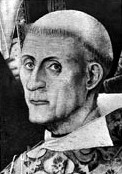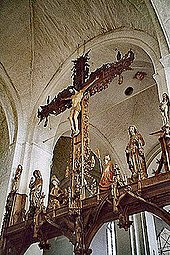Bernt Notke
Bernt Notke (* around 1435 in Lassan ; † beginning - before May 12th - 1509 in Lübeck ) was a Lübeck painter and workshop manager known in Northern Europe , probably the most important in the Baltic region of the late Middle Ages . The question of whether he was also active as a picture carver himself tends to be answered in the negative by current research.
Life
Notke can be traced back to Lübeck in 1467 when he was accepted into the office of painters and glaziers. At that time he had been working here as a painter for a long time and lived in Johannisstrasse, today's Dr.-Julius-Leber-Strasse. It is certain that he completed his training at least partially as a cardboard painter for the sculptor Pasquier Grenier in Tournai . Thanks to major orders in the 1470s, he was able to acquire a house in 1479 on Breite Strasse near the Jakobikirche .
After traveling to Sweden several times in the 1480s, he lived in Stockholm for several years from 1491 . Until 1496 he held the office of Swedish mint master, which was directly subordinate to the imperial administrator Sten Sture the elder . From 1498 onwards, Notke was demonstrably back in Lübeck and stayed here until his death in 1509, from 1505 as foreman of the Petrikirche .
Works
| Johannes altar of the Skåne driver | |
|---|---|
Only three works are documented as creations of Notke or his workshop: the triumphal cross and the rood screen in Lübeck Cathedral, the altar in Arhus Cathedral and the altar in the Church of the Holy Spirit in Tallinn . Further works have been attributed to him in the course of research through stylistic investigations. As an artist based in Lübeck, Notke stands next to Hermen Rode for the great time of the Hanseatic art export in the late Middle Ages to many places in Northern Europe . Henning von der Heyde was one of Notke's most important students . The medieval art trade via Lübeck took place as transit from other parts of Germany and the Netherlands , especially from the Lower Rhine and Flanders ( Bruges ), or from our own production in Lübeck, for which Notke's large workshop stands alongside many others unnamed.
List of works
- Lübeck Dance of Death for St. Mary's Church from 1463; Replaced in 1701 by a copy by the church painter Anton Wortmann , which was destroyed in 1942
- Revaler Totentanz - replica for Tallinn / Reval, remains today in the Nikolaikirche (Estonian Niguliste kirik )
- Wing of the Johannes Altar der Schonenfahrer in the St. Anne's Museum in Lübeck
-
Foundations of the Lübeck Bishop Albert II. Krummendiek for the Lübeck Cathedral from 1477:
- Triumphal cross
- Lay altar in front of the choir
- In the work related to the triumphal cross by the Mayor of Lübeck Andreas Geverdes donated
- Wooden paneling of the rood screen of Lübeck Cathedral
- Altarpiece for the Cathedral of Aarhus 1479
- Retable asus Thurö (today in the National Museum in Copenhagen), donated after 1481
- Altarpiece of the high altar of the Holy Spirit Church in Reval from 1483
- Together with the assistants in his workshop such as Heinrich Wylsynck, he created the colossal equestrian group of St. George in the Nikolaikirche in Stockholm's Gamla Stan as an altar foundation and burial place for the Swedish imperial administrator Sten Sture . A plaster cast has been in the St. Katharinen Museum Church in Lübeck since 1924 .
- Portrait of the Swedish King Karl Knutson Bonde , around 1489, today in Gripsholm Castle
- Gregor's mass , probably from 1503 in the Marienkirche in Lübeck, burned in 1942
- the bronze grave slab for the Hutterock family (1508), which Paatz still ascribed to Notke as an old work, was preserved in the Marienkirche
Unclear attribution
- Altar for the Church of Trondenes near Harstad in Northern Norway
Assistants
- Heinrich Wylsynck (occupied)
- Master of the Revaler Passion (presumed)
gallery
Bernt Notke's Altar in Aarhus Cathedral
literature
- Andrea Boockmann: The destroyed painting of the 'Gregory Mass' by Bernt Notke in the Marienkirche and the stay of Cardinal Raimundus Peraudi in Lübeck 1503 . In: Journal of the Association for Lübeck History and Archeology (ZVLGA) 81, 2001, pp. 105–122.
- Hartmut Krohm: Notke, Bernt. In: New German Biography (NDB). Volume 19, Duncker & Humblot, Berlin 1999, ISBN 3-428-00200-8 , pp. 359-361 ( digitized version ).
- Walter Paatz : Bernt Notke and his circle. Berlin 1939.
- Kerstin Petermann: Bernt Notke. Working method and workshop organization in the late Middle Ages. Reimer, Berlin 2000, ISBN 3-496-01217-X .
- Karlheinz Stoll, Ewald M. Vetter, Eike Oellermann: The Triumphal Cross in Lübeck Cathedral - a masterpiece by Bernt Notke . Dr. Ludwig Reichert, Wiesbaden 1977, ISBN 3-920153-96-0 .
- Hildegard Vogeler , Uwe Albrecht , Hartmut Freytag (eds.): Bernt Notke. The Triumphal Cross in Lübeck Cathedral . Verlag Ludwig, Kiel 2010, ISBN 978-3-86935-033-2 .
- Bernt Notke. Between Innovation and Tradition (uuenduste ja traditsioonide vahel) . Catalog for the exhibition in the Näitus Niguliste muuseumis. Tallinn 2010, ISBN 978-9985-9999-7-4 .
- Alken Bruns (Ed.): Lübeck CVs . Neumünster 1993, ISBN 3-529-02729-4 .
- Jan Friedrich Richter : Triumphkreuzanlage in: Jan Friedrich Richter (Ed.): Lübeck 1500 - Art metropolis in the Baltic Sea region , catalog, Imhoff, Petersberg 2015, pp. 161–165 (No. 3)
Web links
- Literature by and about Bernt Notke in the catalog of the German National Library
- Works by Bernt Notke at Zeno.org .
- Danish / Eng .: Notke and Dance of Death
- Norw .: Altar in Trondenes ( Memento from September 28, 2007 in the Internet Archive )
Single receipts
- ↑ This is also supported by his painting style, which shows elements of panel painting in the north of France in the manner of Nicolas Froment .
- ↑ after Petermann, p. 231
- ↑ According to Walter Paatz, probably identical with the Imperialissima master .
- ↑ The earlier thesis that Sture had the group built to commemorate the Battle of Brunkeberg is rejected today. (Petermann, p. 119f)
- ↑ See Boockmann (Lit.)
| personal data | |
|---|---|
| SURNAME | Notke, Bernt |
| BRIEF DESCRIPTION | Lübeck painter and sculptor |
| DATE OF BIRTH | around 1435 |
| PLACE OF BIRTH | Lassan |
| DATE OF DEATH | before May 12, 1509 |
| Place of death | Lübeck |











